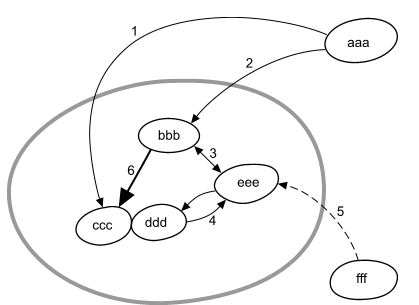3 Influence diagrams

Purpose
An influence diagram represents the main structural features of a situation and the important relationships that exist among them. It presents an overview of areas of activity or organisational and other groupings and their main interrelationships. It is used either to explore those interrelationships, perhaps leading to a regrouping and redefinition of the system and its components, or to express a broad view of how things are in the territory one is considering. Influence diagrams can be developed from a systems map by adding arrows and can be used as the starting point for a multiple cause diagram by clearer definition of the type of influence.
Elements
Blobs of varying sizes
Assorted arrows
Words labelling blobs and possibly also labelling arrows
Key for arrows
Title.
Conventions
- As in systems maps, blob lines represent component boundaries. Inclusion of blobs and a system boundary is optional but highly recommended.
- An arrow (e.g. 1 or 2 in Figure 3) joining component aaa to component bbb or ccc shows that aaa can or does influence bbb or ccc.
- A double-headed arrow (e.g. 3) should never be used to denote a two-way influence unless the influence is identical. Two separate arrows (e.g. 4) are preferable.
- Words (e.g. aaa, bbb, ccc, ddd, etc.) label components and system (if shown). They may also label arrows, if the nature of the influence is not obvious from the context. Alternatively, different influence can be represented by dotted (e.g. 5) or bold (e.g. 6) lines as long as a key is given.
- Arrows do not show material flows.
- An influence diagram, like a systems map, is a snapshot.
- Arrows denote capacity to influence, not a sequence in time.
- A title defining the system of interest is essential.
Guidelines
- Avoid using arrows from features in the environment to the system boundary. By definition factors in the environment affect the system, so such arrows are superfluous. Arrows from environmental factors should terminate at a specific system component where possible. Arrows to the system boundary carry information only if they distinguish different types of influence (see 3 below).
- Different thicknesses of lines can indicate different strengths of influence. Thus 6 denotes a stronger influence than 1.
- It is possible to distinguish different types of influence (e.g. influence via finance, information, supply of materials). Do so only if such distinctions are important and not self-evident, by the use of different lines (colour, dashing) to show this, and a key to explain them.
- Resist the temptation to overload the diagram with information. It may be helpful to you to put down all influences you can think of at first, but for communication to others, select the significant ones.
- Resist the temptation to use double headed arrows. Use them only when the influence is truly reciprocal and of the same type. If you are not careful the use of a double headed arrow can obscure important differences in the types of influence and their magnitude, which is seldom, if ever, equal. Use two arrows pointing in opposite directions instead.
- Space and relative distance can also be used to suggest things about the nature of the relationships shown, e.g. an important but remote relationship.
